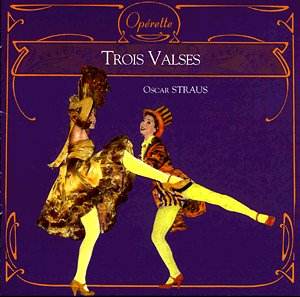This three-act frolic was put together by Oscar
Straus as a vehicle for the waltz music of the Strauss composers,
Johann (father) and Johann (son), together with his own Viennese
music of the familiar style.
It was first presented in Zurich and its initial
success prompted a version to open at the Bouffes-Parisiens two
years later. It was the Paris version that brought it world fame
(with Yvonne Printemps and Pierre Fresnay, her husband, in the
title roles). No doubt it helped Paris was hosting a world trade
fair at the time and was crammed with international visitors.
The libretto by Knepler and Robinson devotes
each of its three acts to the periods– 1865, 1900 and 1935. It
follows three generations of a theatrical family, starting with
Fanny Pichler (a ballerina) in Act I. Act II follows Fanny's daughter,
Charlotte Pichler (a famous operetta singer), while Act III covers
Charlotte's daughter Franzi (a big film star). A focus of interest
in each act is a waltz number.
The French version differs in that the dates
were adjusted to coincide with the occasions of three Paris expositions
– 1867, 1900 and 1937. Also, the main lead was altered to become
a non-singing part for Fresnay, its director. The lead character
has her names changed to Fanny, Yvette, and Irène.
The Paris production was a triumph and all of
Paris turned out to see it. An expensive film version was put
together to maximise the show's popularity, yet an English version
for New York and London ran for a mere 12 weeks. As Traubner observes,
this was the last of the successful Viennese shows to be known
outside Austria.
The stirring music is well played in this the
only recording, and the soloists don't disappoint either. Susy
Delair as Fanny has a warm and lilting style that blends well
with the waltz themes. The Brunners complement each other admirably
in their Act I duet/dialogue number.
I thought that the orchestral opening to the
Brunners' duet opening was 'The Parade of the Tin Soldiers'.
One will also detect the Radetsky March amongst the kaleidoscope
of scenes and songs. Blareau has the orchestra playing with due
sensitivity and rhythm.
This set is well recorded with a warm ambience.
It is also much better filled than most of the series. The
notes in French are not very helpful in explaining the background
to the piece. A soloist Mme Jules is not indicated in the cast
list. The set, as the rest of this series, is provided with an
attractive card case in place of the dreary jewel box
Raymond
Walker
Operette
series from Universal Accord reviewed
by Ray Walker
Further reading: "Operetta", Traubner (Oxford 2003);
‘Musicals", Ganzl (Carlton 1995)
